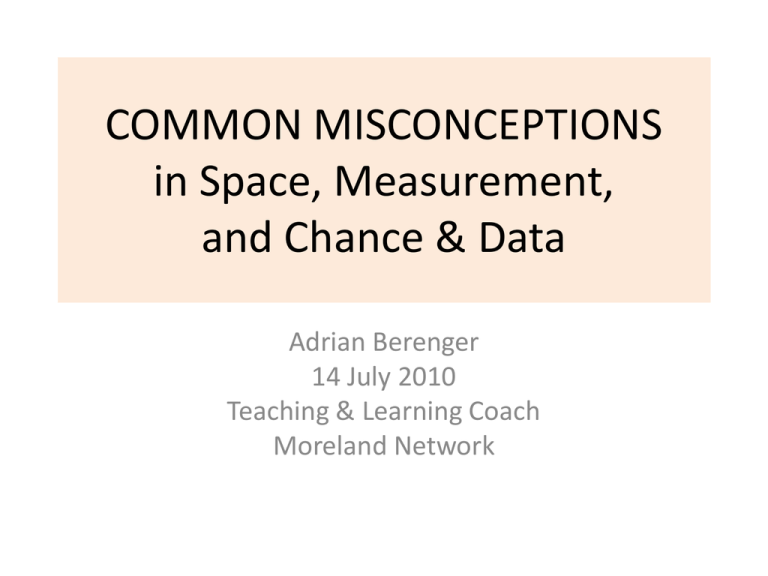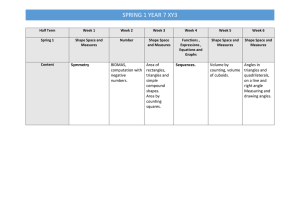Space, Measurement & Chance Misconceptions
advertisement

COMMON MISCONCEPTIONS in Space, Measurement, and Chance & Data Adrian Berenger 14 July 2010 Teaching & Learning Coach Moreland Network SPACE • • • • Language Orientation & Modelling Limited Definitions Mathematical Tools Language • Imprecise – words in mathematics take on different meanings – What does volume mean? – What’s the difference between volume and capacity? – What is a solid in mathematics? • Van Hiele Levels (recognition, analysis, ordering, deduction, rigour) – Language is developmental and so therefore it is vastly different at levels 1 & 2 than at levels 3 & 4 Recognition, Analysis, Ordering, Deduction, Rigour Students at level 1&2 Students at level 3&4 • • • • • • • • corners, pointy like a square diamond a square has four sides angles rectangular rhombus or kite a square has four equal sides and at least one R.A. Mathematical language is and should be different at different developmental levels. Orientation & Modelling • Coordinates in mapping are commonly reversed, so the order of ‘horizontal then vertical’ needs to be consistently represented and emphasised. • Map reading depends on the orientation of the viewer with respect to the map itself. • Difficulties with perspective representations • Hidden surfaces in 3D representations Shapes & Solids • Common shapes are not recognised unless they are upright or in their usual orientation. • Younger children tend to describe aesthetic qualities rather than mathematical attributes. Limited Definitions • What is a hexagon? But most would not agree that the following shapes are also hexagons – The first figure is only a regular hexagon. • What is a polygon? Common Misrepresentations • What is a solid? Mathematically, stability or rigidity does not define a solid. A solid is a region of space enclosed by a 3-D figure. It may be a rigid structure but need not be. It may be open or closed. It may be regular or irregular. • What is a shape? A shape is the appearance of something especially its outline that is not dependent on size, position or orientation. It need not be 2dimensional. A regular shape is not simply one that is common. A regular shape is one where all its sides and angles are equal. REGULAR REGULAR IRREGULAR Symmetry • Students find more lines of symmetry than actually exist. – Simple or convenient definitions that lines of symmetry ‘chop’ shapes into half do not necessarily imply that these lines must also create one half the exact mirror image of the other • How can ICT be used to overcome this misconception? • Angles should be defined as the ‘amount of turn’. – Modeling with two stick joined together of different lengths is important to overcome this common misconceptions with angles. • What other terms can be used to develop completeness of definition in relation to angles? eg. pivoting, rotation • What other modeling can be used? eg. clock hands • The diagonal of a square is the same as its side Mathematical Tools • Reading and using the scale of a protractor Misconceptions • ‘…a rectangle is a long shape…’ • ‘…a square is not a rectangle…’ • This is a square, this is a diamond. a b • angle a is smaller than b • a right angle and left angle Children associate the word right with directional language. Misconceptions • A triangle is not a polygon. • Using a protractor. • The diagonal of a square is the same length as its side. • 3D shapes have diagonal lines. • All lines which divide a shape into two equal 'halves' are lines of symmetry. MEASUREMENT • Students perceive volume as a solid measurement and capacity as a liquid measurement. • Mathematical rules for calculating perimeter, area and volume and their units get confused. They often believe that rulers • Squared units for shapes that are not square. Language • Volume and Capacity




![Property`s Of 2D and 3D Shapes.! :] - Odessa R-VII](http://s2.studylib.net/store/data/005712562_2-5f3fcc92381e7510fd57ce4e0ef497c8-300x300.png)






